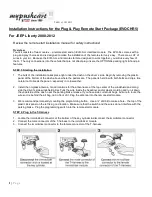
2
PERSONAL PRECAUTIONS AND SAFETY
1. Another person should be close enough to come to your aid when you work near a lead-acid battery.
2. Fresh water and soap should be nearby in case battery acid contacts skin, clothing, or eyes.
3. Wear eye protection and protective clothing. Avoid touching eyes or skin while working with a battery. If acid particles
or corrosion gets into eyes immediately flood eye with cold water (Eye Wash Station) for at least 10 minutes and get
medical attention immediately.
4. If battery acid contacts skin or clothing, wash immediately with soap and water.
5. NEVER smoke or allow a spark or flame in vicinity of battery or engine.
6. CAUTION: Dropping metal tool or other object onto battery may cause spark, short-circuit battery or other electrical
components and may cause explosion.
7. Remove personal metal items such as rings, bracelets, necklaces, and watches when working with a lead-acid battery.
Lead-acid batteries can produce a short-circuit current high enough to cause a severe burn.
POWER CORD CONNECTION
This appliance has a polarized plug (one blade is wider than the other) as a safety feature. This plug will fit into a
polarized outlet only one way. If the plug does not fit fully into the outlet, reverse the plug. If it still does not fit, contact
a qualified electrician. Do not attempt to defeat this safety feature.
PREPARING TO CHARGE
1. Determine voltage of battery by referring to car owner's manual.
2. If necessary, remove battery from vehicle to charge, or to clean terminals, always remove grounded
terminal from battery first. Make sure all accessories in the vehicle are off, so as not to cause an arc.
3. Clean battery terminals. Be careful to keep corrosion from coming in contact with eyes or skin.
4. Add distilled water in each cell until battery acid reaches manufacturer’s specified level. This helps purge excessive
gas from cells. Do not overfill. For a battery without cell caps, carefully follow manufacturer's recharging instructions.
5. Study all battery manufacturers' precautions such as removing or not removing cell caps while charging and
recommended charging rates.
6. Area around battery should be well ventilated while battery is being charged. Gas can be forcefully blown away by
using a piece of cardboard or other nonmetallic material such as a fan.
7. Make sure the initial charging rate does not exceed manufacturer’s recommendation.
CHARGER LOCATION
1. Locate charger as far away from battery as cables permit.
2.
NEVER
place charger directly above battery being charged; gases from battery will corrode and damage charger.
3.
NEVER
allow battery acid to drip on charger when reading specific gravity or filling battery cells with battery acid.
4.
NEVER
operate charger in a restricted or non-ventilated area.
5. Marine batteries must be removed and charged on shore.
6. Do not set a battery on top of charger.
DC CONNECTION PRECAUTIONS
1. Connect and disconnect DC output clamps only after unplugging AC cord from outlet.
2. Never allow clamps to touch each other.
3. Attach clamps to battery posts and check for secure connection. This will hold clamps securely on terminals and helps
to reduce risk of sparking.


























